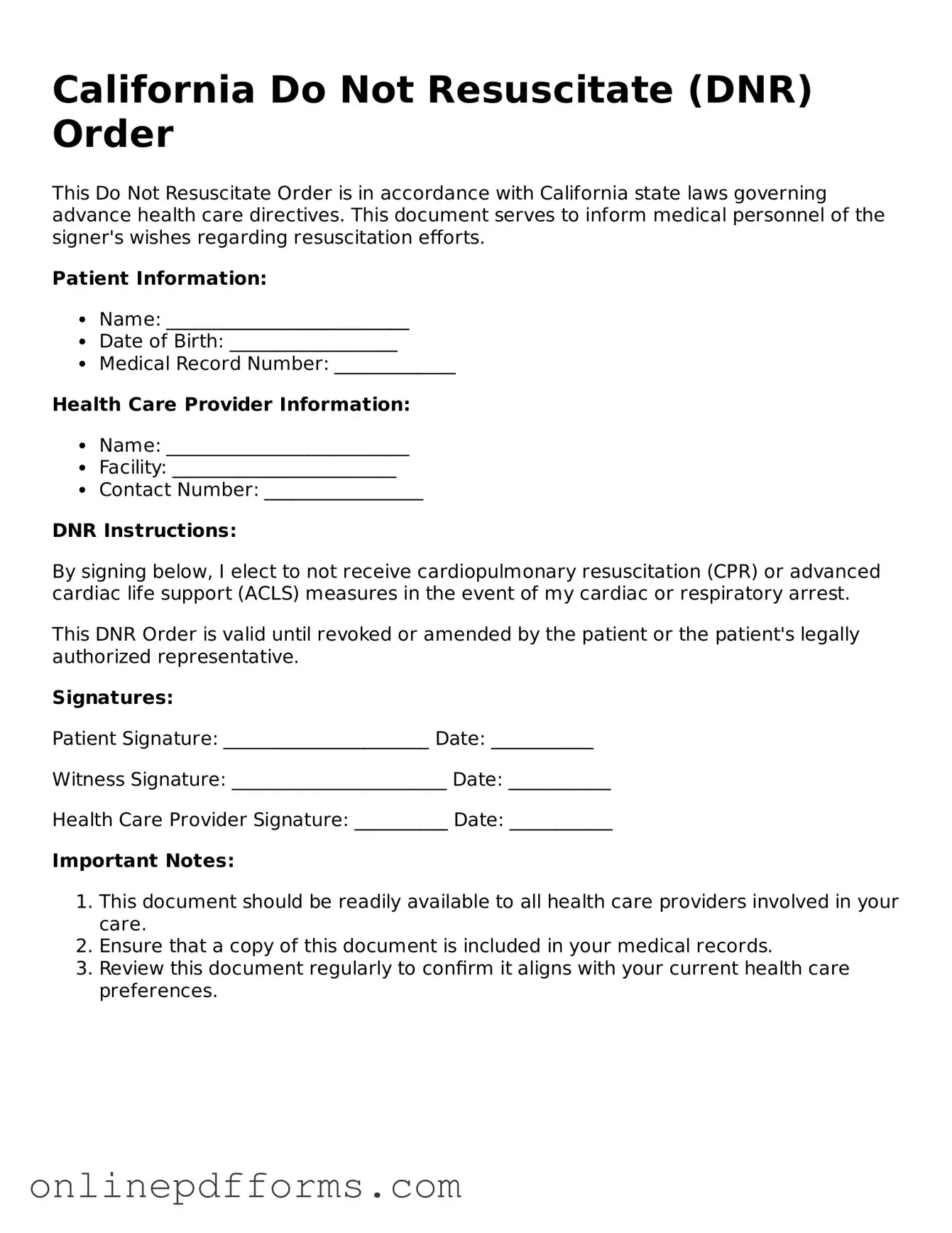The California Do Not Resuscitate (DNR) Order form is similar to an Advance Healthcare Directive. Both documents allow individuals to express their healthcare wishes in advance, particularly regarding end-of-life care. An Advance Healthcare Directive can encompass a broader range of preferences, including appointing a healthcare agent to make decisions on one’s behalf and specifying desired treatments. In contrast, the DNR specifically addresses the issue of resuscitation, making it a focused tool for those who wish to refuse CPR or other life-saving measures in the event of cardiac or respiratory arrest.
Another document that shares similarities with the DNR is the Physician Orders for Life-Sustaining Treatment (POLST) form. Like the DNR, the POLST is a medical order that communicates a patient’s preferences regarding life-sustaining treatments. However, the POLST goes further by detailing a range of interventions, such as the use of feeding tubes or antibiotics, in addition to resuscitation preferences. This form is particularly useful for patients with serious illnesses who want to ensure their treatment aligns with their personal values and medical conditions.
The Living Will is another document that resembles the DNR Order. A Living Will allows individuals to outline their wishes regarding medical treatment in situations where they cannot communicate their preferences. While a DNR specifically addresses the refusal of resuscitation efforts, a Living Will can cover a wider array of medical interventions, including life support and other critical care measures. Both documents are designed to ensure that a person’s wishes are respected when they are unable to express them directly.
Healthcare Power of Attorney (POA) is also similar to the DNR Order in that it allows individuals to designate someone to make healthcare decisions on their behalf. While the DNR specifically instructs medical personnel not to perform resuscitation, a Healthcare POA can include instructions about resuscitation and other medical treatments. This document empowers a trusted individual to advocate for the patient’s wishes, ensuring that their preferences are honored even if they cannot communicate them themselves.
The Comfort Care Order shares similarities with the DNR by focusing on the quality of life rather than aggressive medical interventions. This document emphasizes palliative care measures, ensuring that a patient receives comfort and dignity at the end of life. While the DNR specifically addresses the refusal of resuscitation, the Comfort Care Order can be seen as a broader approach to end-of-life care, prioritizing pain relief and emotional support over life-sustaining treatments.
For those interested in renting a property in Florida, the comprehensive Rental Application process is essential. This form facilitates the collection of vital information that landlords need to assess potential tenants effectively, ensuring a smooth rental experience for both parties.
In addition, the Do Not Intubate (DNI) order is closely related to the DNR. A DNI order specifically instructs healthcare providers not to place a patient on a ventilator or use artificial means to assist with breathing, while the DNR focuses on resuscitation efforts. Both documents reflect a patient’s desire to avoid aggressive medical interventions, but the DNI provides more detailed guidance regarding respiratory support.
The Medical Orders for Scope of Treatment (MOST) form is another document akin to the DNR. Similar to the POLST, the MOST form outlines a patient’s preferences for various medical interventions, including resuscitation. It is designed to be a portable medical order that can be honored across different healthcare settings. This document is particularly useful for patients with chronic conditions who want to ensure that their treatment aligns with their personal values and goals of care.
Finally, the Advance Directive for Mental Health Treatment is similar in that it allows individuals to specify their preferences regarding mental health treatment in the event they become unable to make decisions. While the DNR focuses on physical health and resuscitation, this directive addresses mental health interventions. Both documents empower individuals to maintain control over their care preferences, ensuring that their wishes are respected during vulnerable times.
